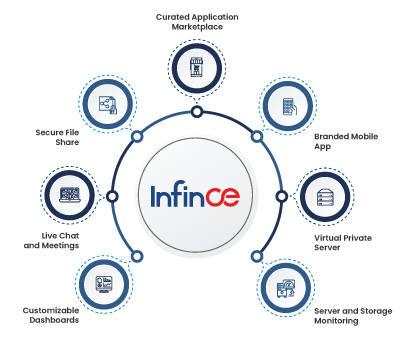Today’s workplace is a sharp deviation from what it was a decade ago. The pandemic has significantly contributed to accelerating the need for change, almost setting a blueprint for the future of work in the long haul.
While the COVID-19 pandemic seems to be dominating headlines all over again now, with new variants posing newer threats to everyday life, regular workplace functioning has taken a beating. Considering the vagaries of this scenario, the much-awaited return to the office in physical work environments seems like a far cry.
Amidst this continuously evolving workplace landscape, organizations worldwide are adopting innovative tools and technologies to keep pace with the dynamic challenges that are characteristic of today’s remote working model.
As we debate how a hybrid model will dictate the post-pandemic workplace, one thing is for sure – the current day workplace is highly digital, offers more flexibility than in the past, and is in a constant state of flux.
Let’s take a look at the many facets of the workplace that have undergone a significant transformation over the past few years and how they have had an impact on overall workplace productivity.
1. Employee-oriented workplace policies
Human resource managers have their tasks cut out with today’s digitally empowered workforce. Both employers and employees today value transparency and frequent communication and are looking forward to embracing an open culture that shuns hierarchy. A recent McKinsey report states that organizations that have clear open policies and approaches, and streamlined communications have employee well-being and productivity rise.
An interesting observation is that organizations with a clear mandate about post-COVID-19 work arrangements have a significant uptick regarding employee-reported feelings of support. There is a three-fold increase in terms of a feeling of inclusion and an almost five-fold increase in individual productivity.
From this, it is clear that a cookie-cutter approach to workplace policies is no longer a sustainable solution.
2. Increased agility in work environments
The traditional on-premises work model would typically include a standard set of tools such as Microsoft Office suite, a company-wide email network, and an internal communicator application. Today, all of this has undergone an interesting makeover. With the advent of the cloud, we are heading towards an entirely cloud-based system that is equipped with smart tools for better collaboration, increased accessibility, enhanced openness, and embracing agility on the whole.
The physical work environment has slowly yet steadily pivoted from a fixed location model to a co-working or collaborative workspace. It is supported by the superior technological prowess of IoT and other smart capabilities. In addition, immersive technologies such as augmented reality (AR) and virtual reality (VR) show increasing readiness for mainstream business adoption, particularly for conferencing and multi-hosting events. Leveraging the power of IoT and other immersive technologies with their limitations is an important step in determining how successful a remote workplace can guide employee productivity. It remains to be seen, although it offers the scope for immense potential at face value.
Read more: How A Collaboration Software Can Improve Productivity
3. Rapid skill enhancement/ upskilling via virtual learning
The pandemic has taught us enough lessons on how it is important to be well-equipped to handle change when things come to a grinding halt. Drastic changes in workload allocation with resource crunches have led to an acceleration in the creation of new roles. In such a scenario, it’s essential for today’s workforce to reskill themselves to fit themselves better and contribute effectively to overall organizational changes. In a Feb 2020 McKinsey Global Survey, 87 percent of executives reported going through skill gaps in the workforce or expected them within a few years. Reskilling and upskilling can be path-breaking because they help employees acquire cross-functional acumen, making it seamless for them to work across different business functions. In the same vein, it is seen that the remote working environment is ripe to facilitate on-the-job learning and self-learning activities.
4. Embracing holistic development with a focus on health and safety
COVID-19 has sounded alarm bells concerning employee health and safety. Therefore, dialogue and discussion in that direction have been on the rise, rightly so. Health and legal experts have mandated the need for on-the-job medical screening as a prerequisite to working in offices in the future. To that end, several global organizations are willing to extend support to employees during the pandemic and in the long run with perks such as providing access to mental health resources and childcare coverage.
5. Sustainability and carbon footprint will assume prime focus
Largely touted as the practice run for the next crisis, climate change, the COVID-19 pandemic has set the stage for organizations to factor in environmental sustainability as a crucial goal. At the same time, they draw up their business objectives. Companies such as Microsoft Corp., Facebook Inc., and Alphabet Inc.’s Google have pledged to become carbon neutral by 2050. Building an environmentally sustainable workplace model must go beyond achieving individual goals such as minimizing carbon emissions. It should be a collective mindset that addresses a mosaic of related issues in tandem and fundamentally becomes the core facet of organizations’ business models.
Read more: Moving to Hybrid Work Culture? Here’s What You Need to Consider!
How does a comprehensive digital orchestration platform like InfinCE come into play while we build a future-ready workplace?
As the hybrid workplace model comes under the spotlight and is here to stay, we can confidently say that technology will play a crucial role in its success. So every organization looking to make a mark at the global level can set itself up for success if they consider digital disruptions the first step toward thriving in their respective industries. Digital tools for friction-free business management can make employee interactions and customer interactions seamless across all types of environments, thus enhancing productivity several notches higher.
An all-under-one-hood enterprise platform such as InfinCE can arm you with the competitive edge you need to have in today’s dynamic work environment. Replete with a wide array of features such as Calendar and Task Management, Intranet and File Exchange channels, Collaborative Document and File management, etc. InfinCE allows you to up your game with digital transformation, reimagined!
Get in touch with us to know more about InfinCE.





